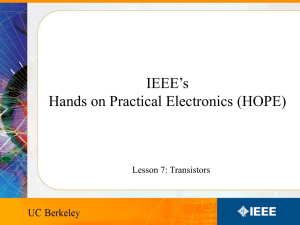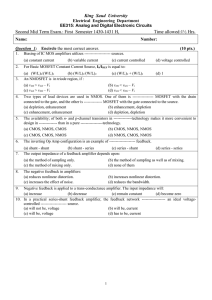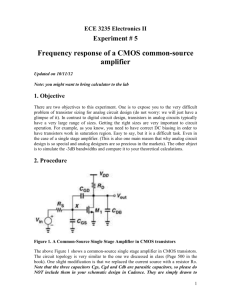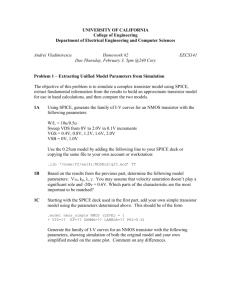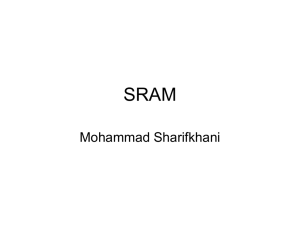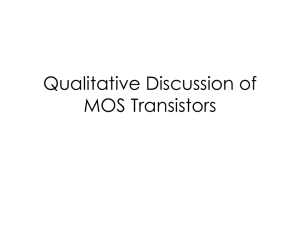Deney5
advertisement
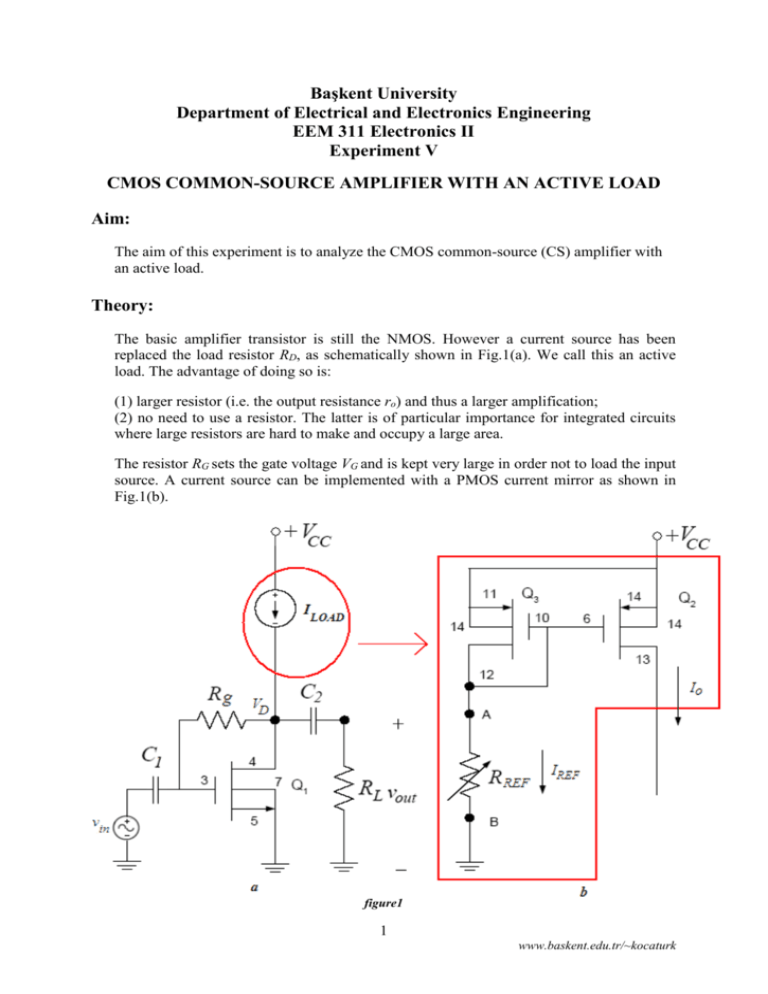
Başkent University Department of Electrical and Electronics Engineering EEM 311 Electronics II Experiment V CMOS COMMON-SOURCE AMPLIFIER WITH AN ACTIVE LOAD Aim: The aim of this experiment is to analyze the CMOS common-source (CS) amplifier with an active load. Theory: The basic amplifier transistor is still the NMOS. However a current source has been replaced the load resistor RD, as schematically shown in Fig.1(a). We call this an active load. The advantage of doing so is: (1) larger resistor (i.e. the output resistance ro) and thus a larger amplification; (2) no need to use a resistor. The latter is of particular importance for integrated circuits where large resistors are hard to make and occupy a large area. The resistor RG sets the gate voltage VG and is kept very large in order not to load the input source. A current source can be implemented with a PMOS current mirror as shown in Fig.1(b). figure1 1 www.baskent.edu.tr/~kocaturk By replacing the current source by the current mirror, we obtain the complete amplifier with active load as shown in Fig.2. We have also added a load resistor RL and a coupling capacitor C2. figure2 2 www.baskent.edu.tr/~kocaturk Preliminary Work: In laboratory you will construct the circuit in Fig.2 using the MOSFET Chip CD4007 and following values ; VCC RL Rg C1 C2 15 V 100kΩ 1 MΩ 10μF 10μF The NMOS has μoCox= 166.67μA/V2, W/L=3 and VT = 1.45V. Assume VA =1/λ =100V. The PMOS has μoCox= 166.67μA/V2, W/L=3 and VT = -1.3V. Assume VA =1/λ =100V. (You can download data sheet CD4007C.pdf from course web page). The Pin Diagram of the CD4007 Chip is in Fig.3. Reference: [1] The values given for the μoCox(W/L) and VT found using the measured data on the CD4007 chip were provided courtesy of Dr. David M. Binkley, Associate Professor at the University of North Carolina at Charlotte and Clark Hopper M.S, R.A. and Harold Hearne M.S., R. A. both also at the University of North Carolina at Charlotte. figure3 1. Find the value of RREF, so that the DC value of IREF is 0.6mA. 2. Find the Q point of the NMOS transistor (ID and VDS) and its operation region. 3. Draw the small signal AC equivalent of the circuit in Fig.2. 4. Derive the overall voltage gain equation Av=vout/vin for the CS amplifier shown in Fig. 2 and find the value of overall voltage gain.(Show all your work clearly) 5. Find the input impedance Rin. 6. Simulate the current mirror using PSPICE. You will need to use a model for the CD4007 transistor. The models can be found in the CD4007.LIB library. a. Construct your circuit in Fig.2 in Pspice.(***MΩ=MegΩ in Pspice***) b. Bias simulation. Simulate the circuit of Fig.1. Do a BIAS simulation and find the reference current IREF, output current Io and the DC voltages(VD, VG, ), current ID of the NMOS transistor. Compare the results with the one you calculated in preliminary work. 3 www.baskent.edu.tr/~kocaturk c. Next, do a Transient simulation. Use as input signal a sinusoidal source (VSIN) of 5 kHz frequency and amplitude of 50mV Peak-to-Peak. Find the input and output voltage. What is the voltage gain? Compare the simulation results with your hand calculations. d. Replace and emulate the resistor RREF with a NMOS transistor, Q4 between points A and B in Fig.2. Do the step b. and c. again. figure3 e. What are the consequences of replacing and emulating RREF with the NMOS transistor shown in Figs. 2 and 4? f. Summarize the simulation results in table in table form and hand it in together with the calculations and the simulation print-outs. Label each graph clearly 4 www.baskent.edu.tr/~kocaturk Experimental Work: You will be using the CD4007 MOSFET array as in this lab. This array contains three NMOS and three PMOS transistors as shown in Fig.5. Again, the key point to remember is that the bulk (or substrates) of all NMOS transistors are connected to the VSS (pin 7) and all PMOS substrates are connected to VDD (pin 14). When using this array pin 7 should be connected to the most negative supply voltage or to the source of the transistor. Pin 14 is the substrate of the PMOS and must be connected to the most positive supply voltage in the circuit! The CD4007 MOSFET array should not be connected to circuits with the power on because high transient voltages may cause permanent damage. Therefore, do not apply input signals until you have connected PIN 7 and 14; otherwise, serious damage to the device could result. It should be mentioned that the transistor characteristics of the CD4007 could vary considerably from chip to chip. The transistors may come from a different batch, what can explain why the threshold voltage, the transconductance parameter and the output resistance is different from the one used in the hand calculations and Spice simulation. Precaution: MOSFET transistors are very susceptible to breakdown due to electrostatic discharge. It is recommended that you always ground yourself before picking up the MOSFET chip. Do no touch any of the pins of the chip. Note: Use jumper wires as possible as short on your board to connect the pins of the transistors. Before constructing the circuit, Verify the values of the resistors that you are going to use by measuring their resistances with a multimeter. Make sure that all resistors are within 2% of their marked values. This will assure that your current measurements are accurate Prepare the power supply for VCC to ensure a DC voltage of 15V and adjust the function generator for vin to a voltage level of approximately 50mV Peak to Peak at a frequency of 5kHz. Construct the amplifier circuit in Fig.2 using the values for the resistors RG calculated in the preliminary work section and the values indicated in the preliminary work section. Note: Always turn on the DC power supply before applying the AC signal. Always turn off the AC signal before turning off the DC power supply. 1. Adjust the potentiometer RREF so that IREF is around 0.6mA. After adjusting RREF, record RREF. What is the corresponding output current(drain current of the NMOS) IO? Measure and record DC voltages VA and VG, VD of NMOS transistor and compare these with your calculations. Compare these values with those calculated in the Preliminary work. IO = ID = RREF = VA = VG = VD = 5 www.baskent.edu.tr/~kocaturk 2. Measure the voltage gain of your amplifier: Observe the input and output voltage waveforms on the oscilloscope. Are the input and output waveforms out of phase? Explain. Calculate the voltage gain of the amplifier and compare with your calculations vin vout Av = 3. Measure the input impedance Rin using method at the experiment3.(Rx=100kPOT) Rin = 4. Discuss the advantages of having an active load over a resistive load in the CS amplifier? 6 www.baskent.edu.tr/~kocaturk Experiment Instruments: Experiment Components: 1 1 1 1 1 2 Breadboard Oscilloscope Signal Generator Multimeter DC Power Source CD4007 1MΩ 100kΩ 50k POT 100k POT 10 μF ...............................……………………………………………………………….. Experiment Results Part1 IO = ID = RREF = VA = VG = VD = Part2 Av = Part3 Rin= Student Name : Signature…………….…………. 7 www.baskent.edu.tr/~kocaturk

